This is a Leica Ic 35mm camera made by Ernst Leitz GmbH from 1950 to 1952. The Leica Ic was a variant of the earlier Leica IIIc but without a rangefinder, viewfinder, or any slow speeds. It’s primary purpose was for scientific and specialized photography. This camera is often found mounted to a microscope or reflex housing. When sold with a lens, it came with the collapsible 5cm f/3.5 Elmar. Because of the lack of a rangefinder, the camera is quite compact and light weight. It is ideal for extreme wide angle lenses and other forms of auxiliary viewfinders.
Film Type: 135 (35mm)
Lens: 5cm f/3.5 Leitz Elmar 4-elements
Lens Mount: M39 Leica Thread Mount
Focus: 3.5 feet to Infinity
Viewfinder: None (Accessory Only)
Shutter: Focal Plane Cloth
Speeds: B, 1/30 – 1/500 seconds
Exposure Meter: None
Battery: None
Flash Mount: None
Weight: 518 grams (w/ viewfinder and Elmar lens)
Manual: None
History
If you were to take any single product ever made in the entirety of human history and find one that has had more of a greater influence on everything that followed it, you would be hard pressed to find one that had as great of an influence on it’s industry than the first Leica camera.
 Leica is the brand (and company) that has been copied, cloned, mimicked, replicated, and inspired the most out of any single product or maker ever in any industry.
Leica is the brand (and company) that has been copied, cloned, mimicked, replicated, and inspired the most out of any single product or maker ever in any industry.
It’s this notoriety that has given Leica a legendary place in the history of photography. Perhaps even more amazing is that their reputation survived two world wars, two German economic collapses, the rise of the Japanese camera industry, the advancement of electronic and CPU controlled cameras, and the digital camera revolution. Leica is still a respected brand, and a name that when mentioned within earshot of any photographer, will cause them to take notice.
You can figuratively throw a rock on the Internet and find some kind of Leica information site on the web. A Google search for “Leica History” will tell you anything you could possibly ever want to know about the Ernst Leitz company, their earliest products, every model they’ve ever made, and how well they’ve done over the past century, so I’ll try not to repeat too much information here.
What follows will be my very best attempt at a Cliff’s Notes version of the history of the Leica camera…
In 1849, German mechanic and mathematician Carl Kellner published a paper describing a new optical formula he had developed in the field of microscopy. His new formula was capable of rendering an image with correct perspective, free of the distortions typical of other microscopes of the time. Herr Kellner went on to start the Optisches Institut in Wetzlar, Germany which was an optical institute that made lenses and other equipment for microscopes.
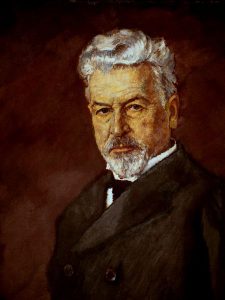
A 21 year old mechanic named Ernst Leitz would move to Wetzlar and become employed at the Kellner Institute in 1864. Leitz had several years of experience making watches in Switzerland, so shortly after starting at the institute, he would be trained as an instrument maker for physical and chemical apparatus.
Leitz must have done a pretty good job, as he was promoted through the institute quickly, and in 1869 became the sole owner of the institute, changing the company’s name to Ernst Leitz GmbH.
Leitz continued pioneering work in the optics industry, focusing mainly on microscopes for medical use. The company earned a high reputation for well built, quality products. Many of their early products were custom tailored for each customer’s specific needs, assuring that very few of these early microscopes were alike.
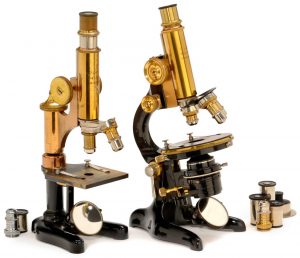
The company grew quickly, and by 1887 had produced it’s 10,000th instrument. Within 4 years, that number doubled, by 1899 the 50,000th was made, and by 1907, the Leitz company had made it’s 100,000th microscope.
By the turn of the 20th century, Leitz had a positive world-wide reputation, and had expanded it’s product offerings to more than just microscopes. The company was a pioneer in labor practices, establishing an 8 hour work day, and company sponsored health care for it’s employees.
In 1902, a German mechanic and industrial designer named Oskar Barnack started work for Carl Zeiss in Jena as a precision mechanic. He was well known in the German optics industry and helped Zeiss expand out of optical lens manufacturing into the photographic industry. Another Zeiss employee, Emil Mechau, had left Zeiss to work for Leitz in 1908 as there was more creative freedom working for Leitz. Around 1911, upon hearing of his friend’s dissatisfaction working at Zeiss, Mechau recommended to Leitz that Barnack would make a good addition to the company.
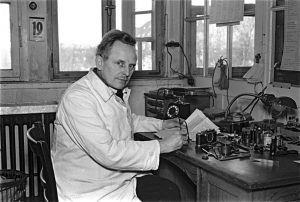
Impressed with his reputation and recommendation by Mechau, Oskar Barnack was recruited by Ernst Leitz to work for him and was offered the head research position for Leitz’s microscope division.
Despite being a skilled mechanic and industrial designer, in his free time Barnack was an enthusiastic photographer. Around 1912, he was tasked to work on a new aluminum bodied motion picture camera that would use 35mm cinema (or kine) film. Oskar Barnack had severe asthma which made him weak, and the aluminum body was chosen to keep weight to a minimum, compared to the heavy wooden cameras of the day.
While working on this new motion picture camera, Barnack often struggled to get the shutter timings right because film emulsions of the day were very inconsistent and often required varying speeds to get the exposure correct. Since cinema film came on very long spools, if the timings weren’t correct, a whole roll of film could be wasted if the exposure was incorrect. Barnack set out to develop a type of film tester that would expose a single frame or two of a new roll to test it’s speed, and once he could determine the correct timings for that roll of film, he could calibrate his motion picture camera to expose the rest of the roll consistently.
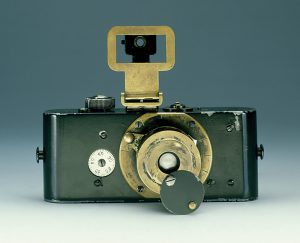
Barnack’s first prototype of his single frame tester was completed in 1913 (some sources say 1912, but I believe 1913 is correct). Upon it’s completion, Barnack’s tester had no official name, but in the years that would pass, this original device has earned the name “Ur-Leica”. The prefix “ur” in German means prime, original, or first.
The Ur-Leica was designed to use the same 35mm cinema film that would have been used in cinema cameras, but in order to increase the exposed image size, he made it so the film would travel through the camera horizontally, which doubled the size of the exposed frame resulting in images that were 24mm x 36mm.
Even though it wasn’t his original intent, the Ur-Leica turned out to be the inspiration for the first Leica still frame camera. By 1913, the idea for a still frame camera that used 35mm cinema film was not new. Prior to Barnack’s tester, other manufacturers such as C.P. Goerz and Ernemann had already designed models that did the same thing. There was no set film standard for motion picture film at the time, so early 35mm still frame cameras often relied on paper backed unperforated motion picture film that was shortened and loaded into custom, hand built 35mm cameras. These cameras fed the film vertically, just like cinema cameras would have, producing an exposed image size of 18mm x 24mm, exactly half of Barnack’s tester.
Oskar Barnack was said to be impressed with the images made from the Ur-Leica, and saw the potential for a new type of still frame camera shooting “double sized” 24mm x 36mm images. It’s small size meant it would be easily portable, and when combined with a quality lens, would be capable of highly detailed images that would enlargen well. Despite the promise of what a new still camera could offer, the idea to mass produce the camera would not materialize for nearly a decade.
There were multiple reasons for this. The first being that Leitz was a world leader in the microscope industry, and while cameras might have been a logical branch for the company to pursue, it’s demands for current products limited the amount of resources that could be given to a new camera department. But more significant reason was the onset of World War I in Germany which halted a lot of German industry, and by the end of the war, had decimated the German economy. Further complicating matters, the senior Ernst Leitz would pass away in 1920, and the entire operation of the company would pass onto his son, Ernst Leitz II.
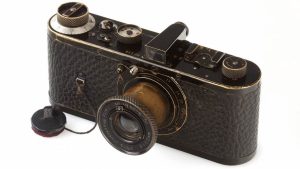
By 1923 however, the Leitz company recovered enough to allow Barnack to convince Leitz II to allow him to use his 1913 prototype to manufacture a limited run of 25 (some sources say 31) cameras that could be given to photographers to test. Although these prototypes were never sold or given any kind of “official” Leica name, in the world of Leica history, these first cameras have become known as the Null Series or sometimes as the Leica 0.
The Null Series cameras must have received enough positive feedback that in 1924, Leitz allowed for a limited production run of 1000 Leica cameras. The name Leica was chosen as a combination of “Lei” from Leitz, and “-ca” from camera. The practice of combining a part of the company name with “-ca” was common in the early years of the Japanese camera industry with names like Yashica, Nicca, and Konica.
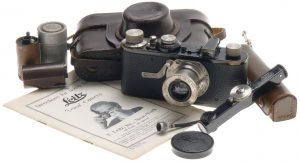
The new Leica camera was revealed in 1925 at the Leipzig Spring Fair in Germany as the Leica I. The camera was an immediate success as it was the first ever compact camera designed for 35mm cinema film made with top notch quality, by a reputable optics company as opposed to some hobbled together model built with very low quality control standards.
The first Leica I had a cloth focal plane shutter with speeds from 1/25 – 1/500, a fixed scale focus viewfinder, and a non-removable, but collapsible Leitz 50mm f/3.5 lenses. The lenses available on these early cameras changed from a simple Leitz Anastigmat, to an Elmax, finally settling on the Elmar.
The Leica I had several minor revisions to it’s design over the next few years, but in 1930 was upgraded to allow for interchangeable lenses, using a 39mm screw mount. This 39mm screw mount became so successful that it earned the nickname Leica Thread Mount, or LTM for short.
In 1932, an all new model, called the Leica II was released with a coupled rangefinder added to the body of the camera. The rangefinder was not integrated into the main viewfinder, but was instead visible in a second window next to the main viewfinder. Although primitive today, this was revolutionary stuff at the time as the only rangefinder aides at the time were auxiliary ones that were used completely separate from the camera, or attached to an accessory port.
Both the Leica I and II were huge successes all over the world. While Leitz had enjoyed a very positive reputation as a leader in the microscope industry, it was the Leica camera that would elevate the company to levels never before possible.
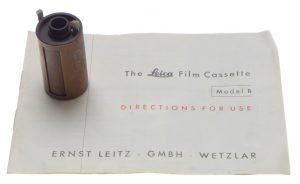
The film used in both these early cameras was bulk cinema film that a photographer could spool him or herself using large spools of uncut cinema film and then load into custom Leitz film canisters. While this was an acceptable method for loading film in 1932, the photographer would have to cut and spool his film in a dark room, and loading the camera required very low light so as not to accidentally expose the film.
In 1934, the Eastman Kodak company out of Rochester, NY would release an all new format of 35mm film that came pre-loaded in metal canisters which they would refer to as 135 format film. This film was designed from the very beginning to be fully compatible with both Leica cameras, and the Contax camera which was a competing model made by Zeiss-Ikon.
Kodak would release it’s own line of German built 35mm cameras called the Retina series, which were the first cameras designed specifically for this new 135 format film, however the basic specifications needed to match the Leica I and II’s body, because Kodak knew that in order for it’s new film to have a chance to succeed, it had to be compatible with the world’s best selling cameras.
Eliminating the need to custom cut your own cinema film and allowing for subdued daylight loading, Kodak’s 135 format 35mm was an immediate success. But it also had the side effect of making the Leica even more popular as well, since the film was easier and safer to load without a darkroom.
The Leica line would continue to evolve with the Leica III in 1933, which added a front-mounted slow speed dial which brought the slow speeds down from 1/25 to a full second. The Leica IIIa from 1935 bumped the top speed up to 1/1000th of a second.
These early Leicas set the standard for the world’s best cameras of the 1930s. Prior to the second World War, Leica had become so synonymous with quality, that many copies, first from the Soviet Union started to be made. Although the Soviet copies were never branded as actual Leicas, they were screw for screw identical to the original.
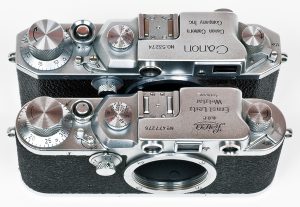

After the war, all of Germany’s patents became null and publicly available to anyone who wanted a crack at making a camera using any part of the design from a German company. Cameras that ranged from exact copies to those just heavily influenced by the Leica came in many shapes and forms from the Soviet Union, Japan, England, the US, and several other countries. While most Soviet made Leica copies were identical to the original design, the more successful and better built Japanese Leica copies were heavily inspired by the original Leica, but almost always had something distinctly different. Canon gained their reputation as a quality maker of cameras by first copying the Leica and improving upon it. As the years went on, these original Leica copies would end up developing into their own distinct models that would eventually look less and less like a real Leica.
Thankfully, the area of Germany where the Leitz company was located was in what would become Allied controlled West Germany, and Leitz’s operations were allowed to continue. Despite having all of their designs and patents copied by many companies all over the world, Leitz kept innovating. For the first few years after the war, they would continue to update and improve the pre-war models with new and unique features.

One of those models was the short lived Leica Ic. An update of the pre war Leica I Model C, the Ic was designed for scientific and specialized photography applications. Leica Ics were often attached to microscopes or telescopes, or to specialized reflex finders that could be paired with extremely long or short lenses. In each of these applications, a rangefinder is useless and can actually get in the way.
According to the LeicaWiki, just over 12,000 Leica Ics were made during it’s short 2 year production run and sold for $70 body only or $140 with the 5cm f/3.5 Elmar lens. When adjusted for inflation, these prices are comparable to $725 and $1450 today.
There is no way to tell exactly how many of these cameras were used in specialized conditions, or just by photographers who didn’t need a rangefinder. The Barnack Leica would continue to be offered with some improvements with the last new model being the IIIg from 1957. By this time, Leitz had already been selling the significantly improved M-series and a large number of competing camera makers had released models that were superior to the original Barnack design.
The entire series of Leica screw mount cameras were some of the most popular cameras ever made, with countless clones, copies, and inspirations made by pretty much every manufacturer of the 20th century (and in the case of the Bessa R, the 21st century). Today, you cannot think of discussing vintage camera collections without at least mentioning a Barnack Leica. The Model Ic being reviewed here was an uncommon model and not one that people are likely to consider, but despite it’s lack of slow speeds and rangefinder, it still has all of the charm and quality of it’s more expensive siblings.
My Thoughts
This Leica Ic is the first Barnack Leica I’ve had the pleasure of shooting. Their high prices have often eluded me, so it was with great excitement that I got to borrow this from my neighbor who said it was an early model. I fully expected some type of rangefinder equipped II or III, but when he produced this short lived model, I was both confused and excited.

For as much of a positive reputation as these early Leicas have, I generally don’t do well with tiny viewfinders. Wearing prescription glasses can often make it very difficult to see through the viewfinders of pre and early post-war cameras. The Leica Ic has no viewfinder of any kind, just two accessory ports on the top of the camera.
This particular example has a standard Leica Elmar 5cm f/3.5 collapsible lens. Despite having 4-elements, this lens is reported to have a formula based off a Cooke triplet lens. The advantage of this lens formula is that it is very simple to manufacture and produces good images. Many of these old Elmars have been adapted to modern digital cameras with great results.
As I handled the camera, I became more excited than I thought I would be. In 2017, I wrote in my review for the Retina Ib saying that despite it being scale focus, it was my favorite Retina. Sometimes with old cameras, less is more, and maybe that would be true here. With the Leica, came an Ernst Leitz Wetzlar 5cm auxiliary viewfinder, and some type of auxiliary rangefinder.
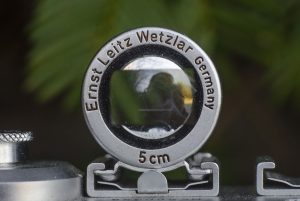
I was prepared for a minuscule rangefinder viewfinder, but ended up with what turned out to be one of the largest and brightest viewfinders I’ve ever used on a classic camera. Looking through this viewfinder was similar to that on the Voigtlander Vitomatic IIa which I previously declared one of my favorite viewfinders.
Of course, it being on top of the camera, there’s parallax correction that must be manually taken into account, but when mounted to the center accessory port, the viewfinder is directly above the camera’s lens which means only vertical parallax correction is needed, rather than a combination of vertical and horizontal like on most scale focus cameras.
With an unexpected amount of excitement for this Leica, I was ready to load in some film and go out shooting. Well, not so fast. For anyone whose ever shot film in a Barnack Leica, you know what I’m about to talk about next…..
Loading Film Into a Barnack Leica
There already is a lot of info on the Internet about loading film into Barnack Leicas, and some of it makes it sound more intimidating than it needs to be. Yes, you need to take the additional step of trimming the leader, but otherwise it’s really not that hard.
I can certainly understand why Leitz went with the bottom loading design when the camera was first created in the 1920s, but why they continued building them like this decades later is a mystery, but whatever the case, here’s all you need to know.
Step 1: Remove the bottom of the camera by turning the lock ring from ZU (locked) to AUF (Open) and lifting it off. With the bottom plate off, pull out the empty take up spool.
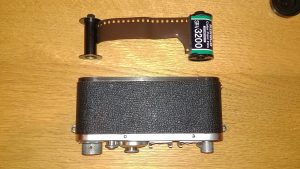 Step 2: Pull out the leader on a new roll of film about twice the length that normally sticks out of a new roll. Get a pair of scissors and cut the leader so the narrow part is approximately 10 cm. A better measurement is that the narrow leader should extend from the takeup spool to the chamber where a new cassette will go, like in the image to the right.
Step 2: Pull out the leader on a new roll of film about twice the length that normally sticks out of a new roll. Get a pair of scissors and cut the leader so the narrow part is approximately 10 cm. A better measurement is that the narrow leader should extend from the takeup spool to the chamber where a new cassette will go, like in the image to the right.
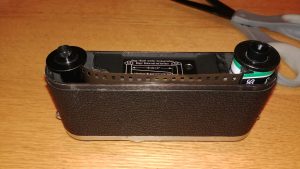 Step 3: Attach the leader to the take up spool so that only one row of perforations (the sprocket holes) extends across the same width of the camera from the take up to the supply side and insert it into the camera with the sprocket side up. Gently press down on both the takeup spool and cassette with even pressure and make sure they go down all the way, ensuring that the film does not snag on anything on it’s way in. Most Barnack Leicas have a decal on the bottom plate that illustrate how the film needs to be inserted into the camera so make sure you get the film path correct.
Step 3: Attach the leader to the take up spool so that only one row of perforations (the sprocket holes) extends across the same width of the camera from the take up to the supply side and insert it into the camera with the sprocket side up. Gently press down on both the takeup spool and cassette with even pressure and make sure they go down all the way, ensuring that the film does not snag on anything on it’s way in. Most Barnack Leicas have a decal on the bottom plate that illustrate how the film needs to be inserted into the camera so make sure you get the film path correct.
 Step 4: Make sure the film advance/rewind lever next to the shutter release is set to “A” and with the bottom still off, advance the film one exposure to make sure that the film is traveling correctly from the cassette to the takeup spool. If the film transport doesn’t seem to be smooth, or you feel like something is stuck, don’t keep turning the film advance knob. Pull everything out and start again.
Step 4: Make sure the film advance/rewind lever next to the shutter release is set to “A” and with the bottom still off, advance the film one exposure to make sure that the film is traveling correctly from the cassette to the takeup spool. If the film transport doesn’t seem to be smooth, or you feel like something is stuck, don’t keep turning the film advance knob. Pull everything out and start again.
Step 5: Reattach the bottom plate of the camera, set the lock ring back to ZU (locked), and reset the exposure counter to 0.
My Thoughts (Continued)
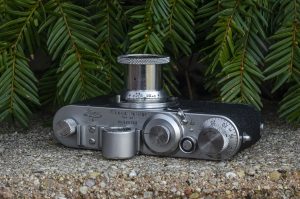
With film loaded in the camera, the Leica Ic is surprisingly easy to use. Like most Leica copies…I mean Leicas (I’m not used to dealing with the real thing!), the control layout is pretty familiar. Rewind knob on left, twin accessory shoes, shutter speed dial, advance/rewind lever, shutter release, and combined film advance knob and exposure counter.
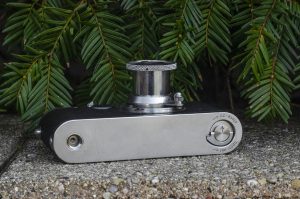
Unlike most other Barnack Leicas, the Ic has no slow speeds. There are six speeds from 1/30 – 1/500 plus Bulb.
The bottom of the camera is nearly barren with only the European spec tripod socket (meaning you can’t simply attach an American tripod without an adapter) and the dual language Open/Auf and Close/Zu bottom plate lock.

Since the Leica Ic is a bottom loader and has no viewfinder, there is literally nothing on the back of the camera, just a large expanse of the deep textured body covering.
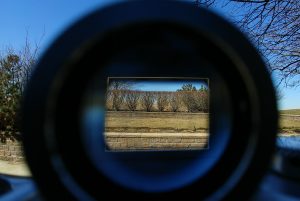
The Leica Ic doesn’t have it’s own viewfinder, so you need to attach some other type of auxiliary viewfinder. Leitz and other third party manufacturers made a large number of different viewfinders that will all work. In many cases, you can even use sports finders or accessory viewfinders made for other cameras such as the Yashica Electro and the Argus C3, as long as it has a standard accessory shoe. In my case, I’m using a genuine Leitz 5cm viewfinder and the image is very large and bright. The viewfinder has frame lines for the 50mm frame and parallax hash marks. The Leica Ic has two accessory shoes, and although the viewfinder will mount in both of them, it works better if it’s in the center one immediately above the lens.
I find this combination of a larger and brighter scale focus viewfinder to be far superior and more useful than the tiny rangefinders that almost every Barnack Leica came with. In my review for the Kodak Retina Ib, I declare it’s scale focus setup to be my favorite Retina for the ease and speed to which I can shoot using zone focus, compared to squinting at a tiny rangefinder patch like in other Retinas. For those who might see this Leica Ic as a “lesser” Leica due to it’s omissions, I say that sometimes “less is more”.
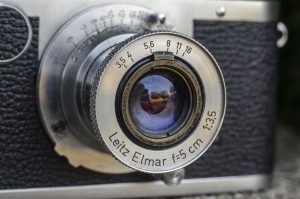
When shooting with the Leica Ic and the Elmar lens, make sure you remember to extend the lens and not shoot it with the lens still collapsed, or you’ll have horribly out of focus images. The lens itself focuses from just under 3 feet to infinity and has a front ring for changing the size of the iris. It can be a little tricky changing f/stops while out shooting as you need to pull the camera from your eye and look at it to change it.
My Results
I knew the Leica Ic had some condition issues when I first got it from my neighbor and I fully expected there to be some light leaks and perhaps some inconsistent slow speeds while shooting, so I had pretty low expectations for it. In an effort to give myself as much latitude as possible, I chose a roll of fresh Bergger 400 black and white film hoping that the faster speed would allow me to use the speeds in the winter months when I had this camera, and also have increased latitude in case the shutter speeds weren’t correct.
One of the first things you should do when shooting a camera with a cloth focal plane shutter, is to check the material for pinholes, cracks, or any other type of light leaks. On most cameras, you open the film compartment, hold up the camera to a light source, and fire the shutter a couple of times and inspect the curtains looking for tears or holes. Unfortunately, with bottom loading cameras like Barnack Leicas, this isn’t possible since you can’t see through the camera. You can see the front of the curtains by unscrewing the lens, but theres no way to see through them.
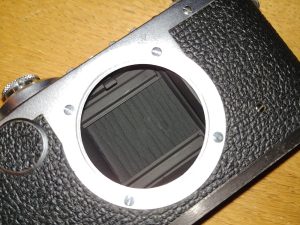
I knew there was a very good chance that the curtains would leak, but I decided to shoot it anyway. I chose black and white Bergger 400 film and shot it in the winter of 2018 hoping the dim light would minimize the amount of leaks. Turns out it didn’t. The good news is that in many cases, like in the For Sale sign on the old car and in the graveyard pictures in the gallery above, the light leaks added a distressed look to the images that looks neat. I also really like the picture of the reflected image of myself in the window.
Beyond the leaks, I could see that the Elmar was a pretty capable lens. The images weren’t razor sharp, but showed a lot of detail across the frame with little fall off. There was also minimal vignetting like you might expect from a mid-century 3 or 4-element lens.
I knew I would never see the full capability of the Elmar lens with the curtains this way, and since this camera belongs to my neighbor, it will soon need to go back, so I wanted to find another way to see what it could do. I could have simply mounted it to any other Leica Thread Mount camera in my collection and shot a fine grained film like Kodak Ektar, but I took it one step farther.
Realizing this was an excellent opportunity to play with a brand new Fujifilm X-T20 digital mirrorless camera that I had purchased in early 2018, I picked up an M39 -> Fuji X-mount adapter and mounted the Elmar to my fancy new digital camera. Of course the sharpness and dynamic range of a modern digital camera is no match for any kind of 35mm film I could have shot with, but I was still curious to see what the Elmar was capable of when paired with a 24 Megapixel X-Trans CMOS sensor.
There is a huge demand for classic film lenses for their adaptability to modern digital cameras, and for good reason. The optical scientists of the early to mid 20th century had already perfected most optical formulas that are still in use today. I expected the Elmar to perform pretty good, but I was not prepared for how good. Each of the images in the gallery above were shot in RAW (Fujifilm calls them RAF files) and post-processed in Photoshop CC.
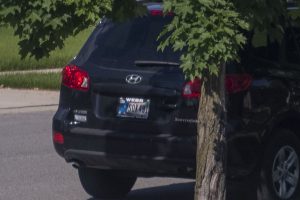
In the first image of the tree sapling, the veins of the leaf and water droplets show a stunning amount of detail. Sharpness is a tad soft compared to what the Fuji’s kit lens is capable of, but it maintains it’s sharpness across the frame in a very pleasing way. In the image of my neighbor’s front yard, you can clearly make out all of the letters of the Hyundai’s license plate, even though it is near the edge of the frame where you’d expect to see some softness. As I witnessed in the film pics, vignetting is non-existent (although due to the nature of the crop sensor on the digital camera, vignetting would be even less visible in the digital images). I do see a little color fringing in contrasty areas of the scene like above the WEBB letters in the 1:1 crop image to the right, but this is something you’d see on modern lenses today.
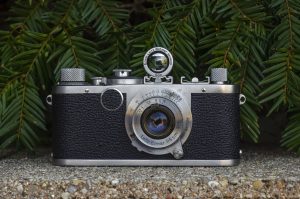
The Elmar held up extremely well under the scrutiny of a modern digital camera with it’s sharp sensor and extreme exposure latitude. The images have that analog character that so many people chase when adapting old lenses. It looks both modern and vintage at the same time.
The Leica Ic may be a specialized camera and one that lacks certain features that most collectors look for, but that doesn’t make it any less of a good camera. In my review for the Kodak Retina Ib, I comment that I prefer a large and bright scale focus camera over the tiny rangefinders that were often found on cameras of the early to mid 20th century. With the large and bright auxiliary viewfinder mounted to the Ic, I find it to be a very capable camera, if only it had a better shutter.
My Final WordHow these ratings work |
The Leica Ic was an uncommon model made for specialized photography and lacked slow speeds or any type of built in viewfinder or rangefinder. This actually works to the camera’s benefit, simplifying the design and operation of the camera, and allowing you to easily use one of many available auxiliary viewfinders. I’ll take a large and bright scale focus viewfinder over a tiny rangefinder any day, and that includes this Leica Ic. I thoroughly enjoyed using it and although the shutter on this camera had many issues, when mounted to a digital mirrorless camera, the Leitz Elmar lens shined, suggesting that a Leica Ic in good working order with this lens is a very capable camera. Don’t let any perceived lack of features on this model lead you to believe this is a ‘Lesser Leica’. | ||||||
| Images | Handling | Features | Viewfinder | Feel & Beauty | History | Age | |
| 1 | 1 | 0 | 2 | 2 | 2 | 30% | |
| Bonus | none | ||||||
| Final Score | 10.4 | ||||||
Additional Resources
http://camera-wiki.org/wiki/Leica_Ic
http://camerapedia.wikia.com/wiki/Leica_Ic
https://www.l-camera-forum.com/leica-wiki.en/index.php/Leica_Ic
https://www.photo.net/discuss/threads/good-functional-use-for-a-leica-ic.115327/

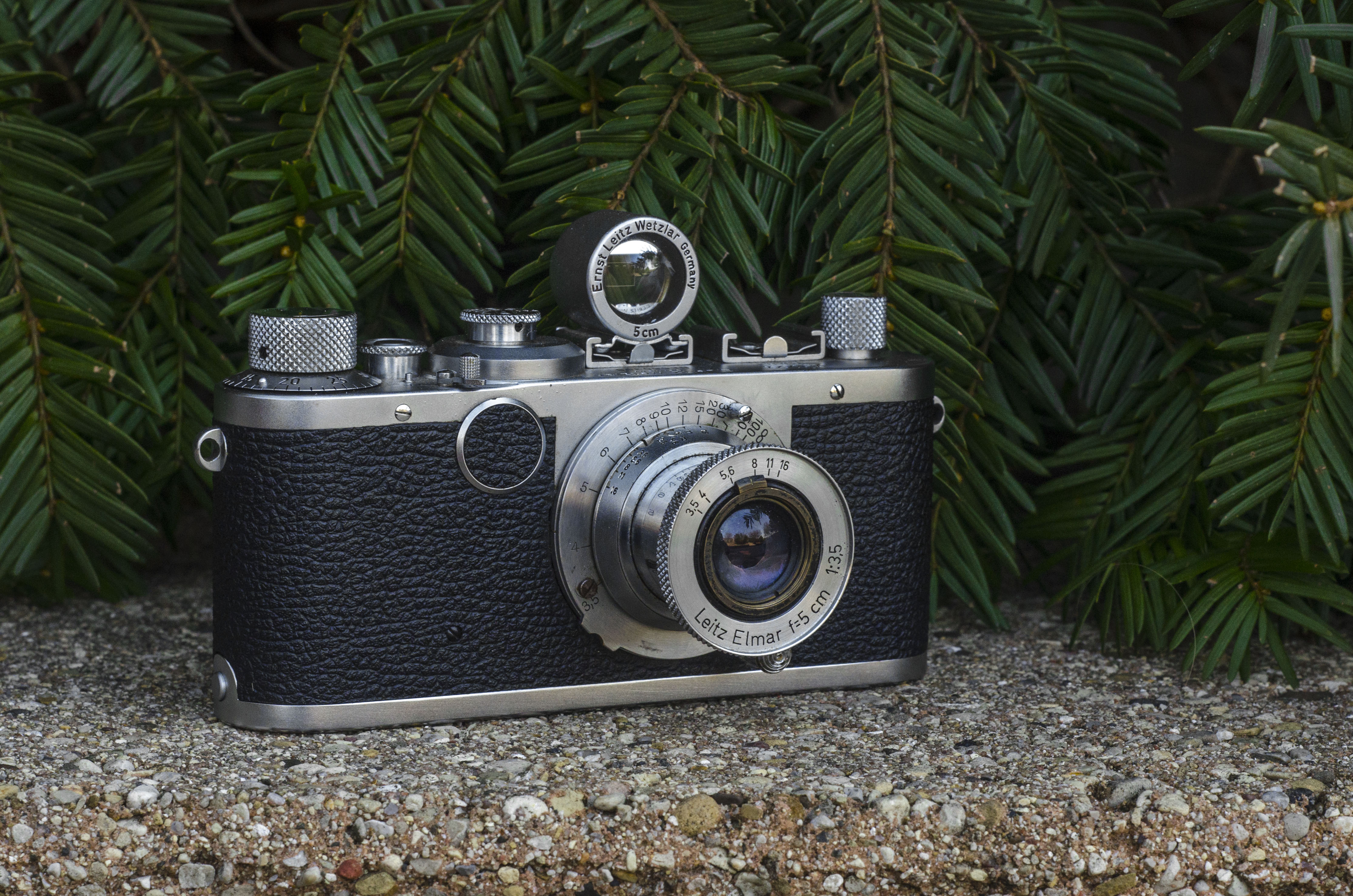
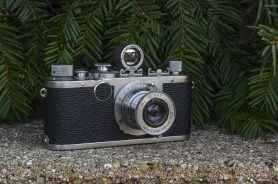
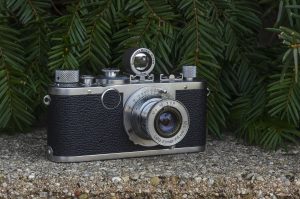
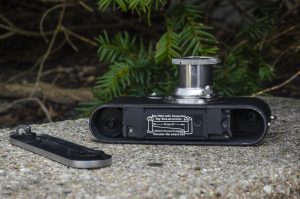













Great article on my favorite line of cameras. I own one of these and have shot Leica screwmounts for years until I went digital. Great lenses especially the post war coated ones. Big safety tip. Cutting the film leader is not an option. If you don’t, loading the camera will be a wrestling match that the Leica will win! Thanks for this review Mike.
The screw, or “Barnack” Leica are very usable today. They are quite a lot smaller than the M series that came out in 1954. In fact a screw mount camera, the 111F red dial was released in 1956, two years after the M3 of 1954. The screw mounts were made until 1960. The trading of “scientific” bodies continued in the M era: the M1 of 1959 had a viewfinder but no rangefinder, 2 frames, 35 & 50mm in the finder. The MD was released in 1964 with no viewfinder at all (use a separate plug-in finder or a visoflex reflex housing). When the M4 appeared in 1967 with improvements, the MDa appeared, no finder but slanted rewind crank and frame counter under a glass window like the M3/4 and not the primitive screw mount pattern of the M2/1/D. In 1977 we saw the M4-2 appear, only in black finish and made in Canada. The MD-2 was the viewfinderless upgrade of the MDa also introduced in 1977 and had a hotshot for flash and provision for winder or motordrive use. It too was all black and made in Canada. The M4-P replaced the M4-2 in 1980 then the metered M6 in 1984.
The MD-2 ran in tandem with all these models until 1988. I have a collection of these viewfinderless M series cameras: an M.D., two MDa, and an M.D.-2. The MD is used with a visoflex 11 and 280mm f4.8 Telyt at cricket matches, the pair of MDa are used as travel cameras with a 3.5cm F3.5 Summaron and 35mm finder SBLOO as with no rangefinder to go out of whack, this outfit is very rugged. Focus is by the Hyperfocal Distance method so no focus at all. Abroad, in very bright conditions – Greece – Tunisia etc – aperture is often at f11-16 so depth of field very great. MD-2 is used with a 21mm F3.4 Super Angulon lens by Schneider with a Leitz 21mm finder. A great outfit in cities. All black so very discreet in use.